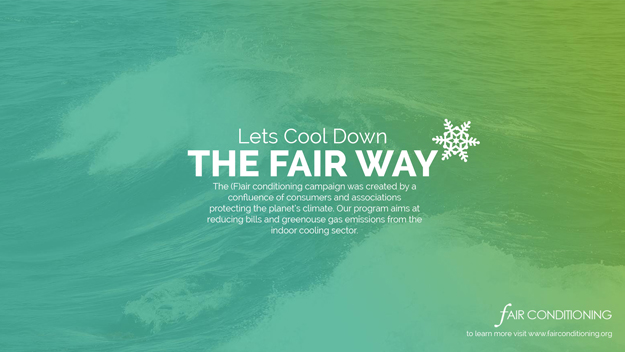Heat loss and heat gain through windows occurs at 20 to 30 times the rate it occurs through walls. Proper window performance can ensure that the heating and cooling equipment can maintain a reasonable level of comfort without excessive operating costs. (Zero Energy Building Envelope Components: A Review)
Glazing in windows traps the heat inside the space. Window glass allows short wave infrared radiation from the sun to pass through easily, but is very resistant to the passage of long wave radiations emitted from objects inside the building that have heated from the solar radiation. The resultant temperature inside the building can thus be even greater than outside unless fenestration systems are not designed carefully. Building fenestrations can affect lighting and air-conditioning loads considerably. (www.nzeb.in)
Glazing also influences daylight harvesting potential by reducing lighting loads without compromising on visual and thermal comfort of building occupants. Achieving balance between daylight penetration and heat gain requires careful calibration between visual and heat transmission qualities of glazing, and the orientation and sizing of openings. Solar radiation intensity is minimum on north facing openings or walls both with respect to quantum and duration, followed by south facing facades. East and west facing openings (or walls) receive a large amount of solar radiation throughout the year. Architects and decision makers can control heat gain and loss through prudent design of fenestrations with appropriate placement and glazing. (www.nzeb.in)
Glazing Properties Relevant for Daylight Harvesting and Energy Efficiency
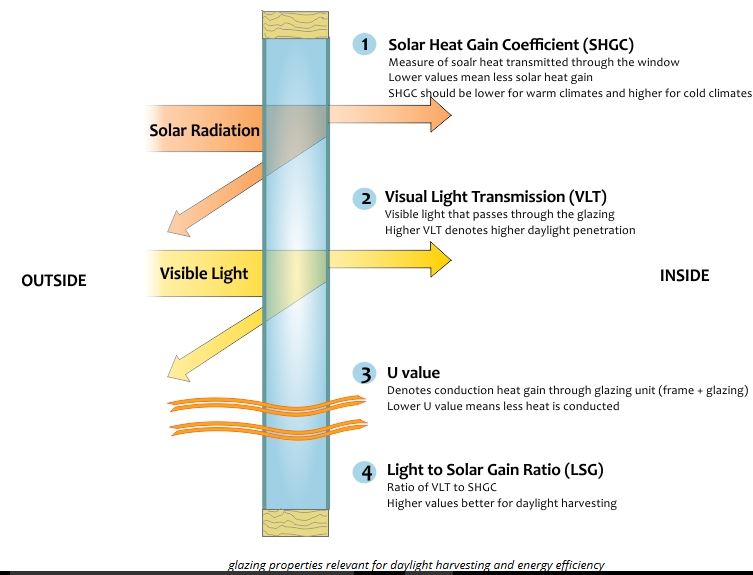
The primary properties of glazing that impact energy are:
- Visible reflectance (affecting heat and light reflection)
- Thermal transmittance or U – value (affecting conduction heat gains)
- Solar heat gain (affecting direct solar gain)
- Spectral selectivity (affecting daylight and heat gain)
- Glazing colour (affects the thermal, and visual properties of glazing systems and thus energy
Representative Solar Heat Gain Coefficients (SHGC)
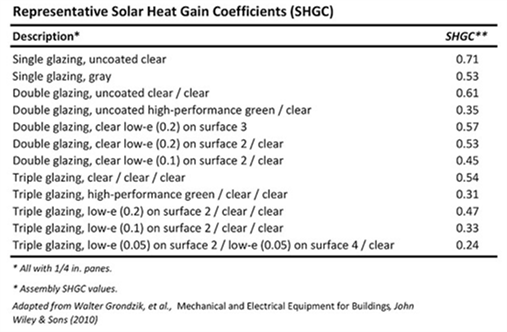
The Solar Heat Gain Coefficient (SHGC) is the fraction of incident solar radiation admitted through a window, both directly transmitted and absorbed, and subsequently released inward. SHGC is expressed as a number between 0 and 1. The lower a window’s solar heat gain coefficient, the less solar heat it transmits. (www.efficientwindows.org)
The visible transmittance (VT) is an optical property that indicates the fraction of visible light transmitted through the window. This is separate from the Solar Heat Gain Coefficient (SHGC), since many modern windows include spectrally selective coatings that can allow different amounts of visible, infrared and ultraviolet light. (www.efficientwindows.org)
Strategies for Improving the Energy Performance of Glazing
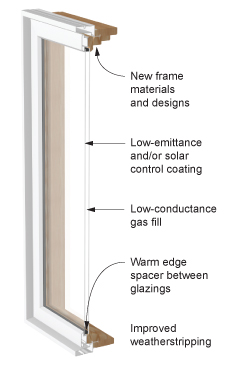
There are three fundamental approaches to improving the energy performance of glazing products (two or more of these approaches may be combined).
- The first approach is to alter the glazing material itself by changing its chemical composition or physical characteristics. An example of this is tinted glazing.
- The second approach is to apply a coating to the glazing material surface. Reflective coatings and films were developed to reduce heat gain and glare, and more recently, low-emittance coatings have been developed to improve both heating and cooling season performance.
- The third approach is to assemble various layers of glazing and control the properties of the spaces between the layers.
These strategies include the use of two or more panes or films, low-conductance gas fills between the layers, and thermally improved edge spacers. (www.efficientwindows.org)
Glazing Types
Single glazing
- Clear Glass: relative to all other glazing options, single-glazed with clear glass allows the highest transfer of energy (i.e. heat loss or heat gain depending on local climate conditions) while permitting the highest daylight transmission. SHGC=0.86. VLT=0.90. U-value= 1.04 (Btu/hr-sq ft °F).
- Tinted Glass: The primary purpose of bronze or gray tinted glass is to reduce solar heat gain.It also reduces visible light as compared to clear glass or even other standard tinted glass products such as green and blue tints (which offer significantly higher visible light transmission). Tinted glass is also useful in controlling glare. Solar heat gain and visible light transmission may be reduced relative to the performance of alternate glazing options such as low-E glass with moderate or low solar gain. The tint has no effect on the U-factor but reduces solar heat gain which may be a benefit in the summer and a liability in the winter depending on local climate conditions. SHGC=0.73. VLT=0.68. U-value= 1.04 (Btu/hr-sq ft °F).(www.efficientwindows.org)
Double glazing
- Clear Glass: A typical clear, double-glazed unit has two lites of glass with the inner and outer layers of glass both being clear and separated by an air gap. Double glazing, compared to single glazing, cuts heat loss in half due to the insulating air space between the glass layers. In addition to reducing the heat flow, a double-glazed unit with clear glass will allow the transmission of high visible light and high solar heat gain. SHGC=0.76. VLT=0.81. U-value= 0.48 (Btu/hr-sq ft °F).
- Tinted glass: A typical double-glazed unit with bronze or gray tinted glass has two lites of glass with the outer layer of glass being bronze or gray tint and the inner layer being clear. Bronze and gray tinted glass products are similar in energy performance. SHGC=0.63. VLT=0.61. U-value= 0.49 (Btu/hr-sq ft °F).
- High-solar gain Low-E Glass with argon glass fill: These windows are designed to reduce heat loss but admit solar gain. High-solar gain low-E glass products are best suited for buildings located in heating-dominated climates and are the product of choice for passive solar design projects. SHGC=0.42. VLT=0.72. U-value= 0.28 (Btu/hr-sq ft °F).
- Moderate-solar-gain Low-E Glass with argon gas fill: These windows are often referred to as spectrally selective low-E glass due to their ability to reduce solar heat gain while retaining high visible transmittance. Such coatings reduce heat loss and let in a reduced amount of solar gain making them suitable for climates with both heating and cooling. SHGC=0.42. VLT=0.72. U-value= 0.25 (Btu/hr-sq ft °F).
- Low-solar-gain Low-E Glass with argon glass fill: As with moderate-solar-gain low-E glass, these windows are often referred to as spectrally selective low-E glass due to their ability to reduce solar heat gain while retaining high visible transmittance. Compared to most tinted and reflective glazings, this low-E glass provides a higher level of visible light transmission for a given amount of solar heat reduction. Variants on low-solar-gain low-E coatings have also been developed which may appear slightly tinted. This type of low-E product reduces heat loss in winter and substantially reduces solar heat gain both in winter and in summer. Thus, low-solar-gain low-E glazings are ideal for buildings located in cooling-dominated climates. SHGC=0.26. VLT=0.64. U-value= 0.24 (Btu/hr-sq ft °F).
- High-solar gain Low-E Glass with argon gas fill and a roomside low-E coating: Adding an additional roomside (also known as the 4th surface) low-E coating to the low-E coating in an insulating glazing unit allows for increased thermal performance without having to add another layer of glass. Infrared heat is generated inside a room. Adding this roomside low-E coating reflects the heat back into the space which reduces the amount of radiant heat loss through the glass. SHGC=0.62. VLT=0.77. U-value= 0.21 (Btu/hr-sq ft °F).
- Moderate-solar-gain Low-E Glass with argon gas fill and a roomside low-E coating: Such coatings reduce heat loss and let in a reduced amount of solar gain making them suitable for climates with both heating and cooling. SHGC=0.41. VLT=0.70. U-value= 0.20 (Btu/hr-sq ft °F).
- Low-solar-gain low-E glass with argon gas fill and a roomside low-E coating: This type of low-E product reduces heat loss in winter and substantially reduces solar heat gain both in winter and in summer. Thus, low-solar-gain low-E glazings are ideal for buildings located in cooling-dominated climates. SHGC=0.27. VLT=0.63. U-value= 0.20 (Btu/hr-sq ft °F). (www.efficientwindows.org)
Double Glazed Grey Tinted Glass : Victory Building, Little Rock, USA
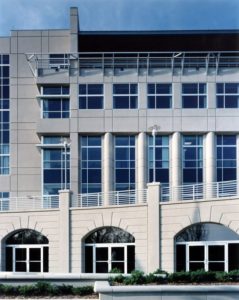
Double Glazed High Solar Gain Low-E Glass
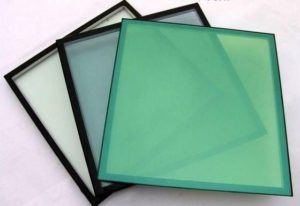
Triple glazing
- High-solar gain Low-E Glass: In this case there are three glazing layers and two low-E coatings, ½″ argon gas or ¼″ krypton gas fill between glazings, and low-conductance edge spacers. The middle glazing layer can be glass or suspended plastic film. Some windows use four glazing layers (two glass layers and two suspended plastic films). This product is suited for buildings located in very cold climates. Both Low-E coatings in this product have high solar heat and visible light transmittance, which is ideal for passive solar design. The use of three layers, however, results in lower solar heat gain relative to double glazing with high-solar-gain Low-E. SHGC=0.55. VLT=0.69. U-value= 0.16 (Btu/hr-sq ft °F).
- Medium-solar-gain Low-E Glass: In this case there are three glazing layers and two low-E coatings, ½″ argon gas or ¼″ krypton gas fill between glazings, and low-conductance edge spacers. The middle glazing layer can be glass or suspended plastic film. Some windows use four glazing layers (two glass layers and two suspended plastic films). This product is suited for buildings located in very cold climates. Both Low-E coatings in this product have high solar heat and visible light transmittance, which is ideal for passive solar design. The use of three layers, however, results in lower solar heat gain relative to double glazing with high-solar-gain Low-E. SHGC=0.38. VLT=0.63. U-value= 0.15 (Btu/hr-sq ft °F).
- Low-solar-gain low-E glass. In this case there are three glazing layers and two low-E coatings, ½″ argon gas or ¼″ krypton gas fill between glazings, and low-conductance edge spacers. The middle glazing layer can be glass or suspended plastic film. Some windows use four glazing layers (two glass layers and two suspended plastic films). With this window, both low-E coatings are spectrally selective in order to minimize solar heat gain. This window is best suited for climates with both significant heating and cooling loads. SHGC=0.24. VLT=0.51. U-value= 0.15 (Btu/hr-sq ft °F). (www.efficientwindows.org)
Triple Silver-Coated Solar Control Low-E Glass: Sandcrawler, Singapore

Before selecting any glazing material, study of building orientation is a must. The suggested glazing orientation in new buildings in different Indian climatic zones may be:
- Hot & Dry: North & South
- Warm & Humid: North & South
- Composite: South
- Moderate: North
- Cold & Cloudy: South
- Cold & Sunny: East & South
Shadow of the building and surroundings also impacts heat ingress (direct & diffused) and hence changes the glazing requirement. A study of the available lux level, window size, and other passive design strategies should be considered before defining the required VLT of a glass. (www.grihaindia.org)
Radiant energy is one of the important ways heat transfer occurs with windows. Reducing the emissivity of one or more of the window glass surfaces improves a window’s insulating properties. (www.glassed.vitroglazings.com)
Comparison of Different Types of Double Glazing
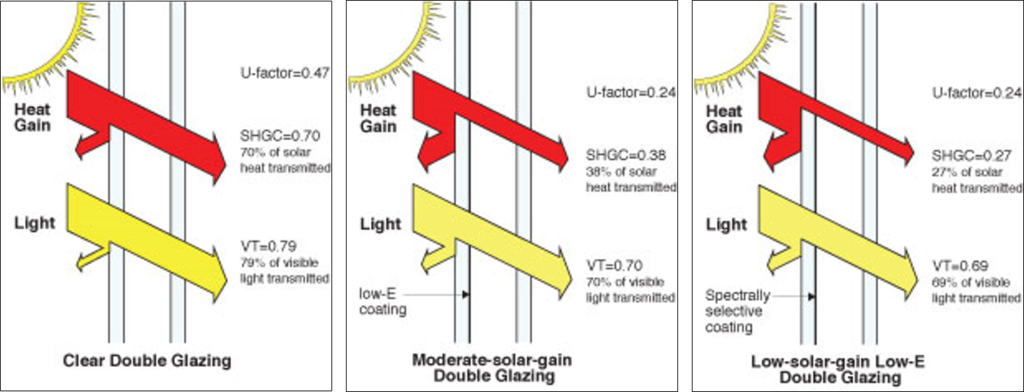
- Glazing area should be optimally reduced so it does not affect the uniformity of daylight distribution in a building.
- Reduce Solar Heat Gain Coefficient (SHGC) as less heat will be transferred into the building.
- Reduce the U-Value of glazing and also lower the SHGC; except for cold climates where higher SHGC is recommended.
- In general cases, specify low U-values for residential applications. Even lower values may be desired in extremely hot climates. For buildings where passive solar heating energy (cold regions) is desired, south-facing windows with high SHGC values coupled with low U-factors should be recommended.
- In climates with significant air conditioning loads, specify windows with low SHGC values (< 0.40). In general, high (>30%) Glass Visible Transmittance is desired, especially for daylighting applications. (nzeb.in)
- When specifying windows performance, take care to specify “whole product performance values” / whole window unit for U-factor and SHGC.
- Use of “glass-only” U-factors should be avoided as they can be 10% to 40% better than the whole product value. (nzeb.in)
U-Values and R-Values of Different Types of Glazing
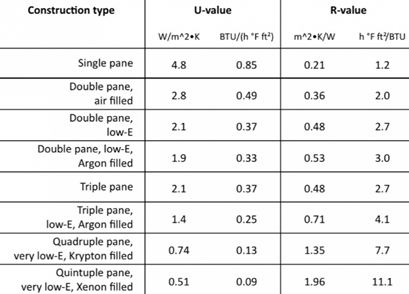
For all climatic zones, vertical fenestration compliance requirements for all three incremental energy efficiency levels, i.e. ECBC, ECBC+, and SuperECBC, shall comply with the following:
- Maximum allowable Window Wall Ratio (WWR) is 40% (applicable to buildings showing compliance using the Prescriptive Method, including Building Envelope Trade-off Method)
- Minimum allowable Visual Light Transmittance (VLT) is 0.27
- Assembly U-factor includes both frame and glass area weighted U-factors
- Assembly SHGC includes both frame and glass area weighted SHGC
Vertical fenestration shall comply with the maximum Solar Heat Gain Coefficient (SHGC) and U-factor requirements of Table 4-10. Vertical fenestration on non-cardinal direction, shall be categorized under a particular cardinal direction if its orientation is within ± 22.5° of that cardinal direction.
Vertical Fenestration Assembly U-factor and SHGC Requirements for ECBC Buildings
| Composite | Hot and Dry | Warm and Humid | Temperate | Cold | |
| Maximum U-factor (W/m2.K) | 3.00 | 3.00 | 3.00 | 3.00 | 3.00 |
| Maximum SHGC Non-North | 0.27 | 0.27 | 0.27 | 0.27 | 0.62 |
| Maximum SHGC North for latitude ≥ 15°N | 0.50 | 0.50 | 0.50 | 0.50 | 0.62 |
| Maximum SHGC North for latitude < 15°N | 0.27 | 0.27 | 0.27 | 0.27 | 0.62 |
Vertical Fenestration Assembly U-factor and SHGC Requirements for ECBC+ Buildings and SuperECBC Buildings
| Composite | Hot and Dry | Warm and Humid | Temperate | Cold | |
| Maximum U-factor (W/m2.K) | 2.20 | 2.20 | 2.20 | 3.00 | 1.80 |
| Maximum SHGC Non-North | 0.25 | 0.25 | 0.25 | 0.25 | 0.62 |
| Maximum SHGC North for latitude ≥ 15°N | 0.50 | 0.50 | 0.50 | 0.50 | 0.62 |
| Maximum SHGC North for latitude < 15°N | 0.25 | 0.25 | 0.25 | 0.25 | 0.62 |
A fenestration system with low U-value and low effective SHGC can result in reduction of heating and cooling demand by 6-11% in moderate climate and between 8-16% in hot humid, hot dry, and composite climates. These savings increase to 8-17% for moderate, and 12-26% for hot humid, hot dry, and composite climates, if high performance fenestration systems are used. Such high performance systems are defined as using low-e glass, frames with thermal breaks, and well designed shading. (www.nzeb.in)
Energy Saving Potential of Multiple Glazed Windows Over Single Glazing (24 hours usage)
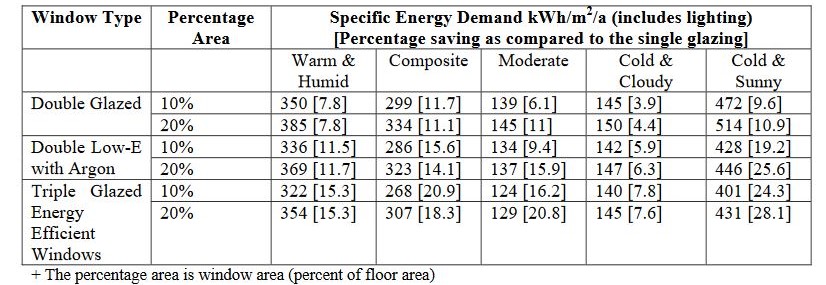
High-performance windows not only provide reduced annual heating and cooling bills, they reduce the peak heating and cooling loads as well. Reducing peak load may allow homeowners to install a smaller heating or cooling system. Smaller HVAC systems cost less and can thereby partially offset the cost of efficient windows. (www.efficientwindows.org)
Using double glazing reduces the internal temperature of the glass because of the reduced conduction of heat from the outdoors. This results in better radiant temperature control and enhanced comfort. This effect can be felt in both heating and cooling, especially in spaces which have large glazed areas. (www.nzeb.in)
Publications
Energy Conservation Building Code (ECBC) 2017.
Inderjeet Singh, Axel Michaelowa, “Indian Urban Building Sector: CDM Potential through Energy Efficiency in Electricity Consumption”, 2004.
Lechner Norbert, “Heating, cooling, lighting. Sustainable design methods for architects”, 3rd edition, 2008.
Online Resources
Tools
Radiance
A ray-tracing program that accurately predicts light levels and produces photo realistic images of architectural space in all sky conditions
THERM: THERM’s two-dimensional conduction heat-transfer analysis is based on the finite-element method, which can model the complicated geometries of building products.
WINDOW: A computer program for calculating total window thermal performance indices
Optics: This is the tool for manipulating optical layers and calculating spectral data for different stacks of optical elements. The program allows the user to combine both glazing layers, e.g. a double pane window, and optical elements, e.g. applied films, laminates, and substrates.
The International Glazing Database
RESFEN – evaluate energy performance of fenestration products for small residential buildings
COMFEN – The Indian version for COMFEN (version 5.0.21) has construction schedules, glazing systems, façade options, occupancy, lighting, equipment and HVAC schedules – all customized to reflect day time and 24 hour operation of buildings in India as well as to suit Indian codes and compliances. It also has weather data of 60 Indian cities for simulation.
| Manufacturer | Product | Contact |
| AIS (Asahi India) Glass Solutions Limited | Insulating glass, laminated glass, automotive safety glass, UPVC windows and doors. Products Brochure: https://www.aisglass.com/sites/default/files/pdfs/Architecture%20Update.pdf | 209-210, Tribhuwan Complex, Ishwar Nagar Mathura Road, New Delhi, Delhi, 110065. Website: https://www.aisglass.com |
| Charan Windows | UPVC double glazed windows | No: 21, Kalaivanar Street Oragadam, Ambattur, Chennai, Tamil Nadu, 600053 Mobile: +918268156282 Website: http://www.charanwindows.in/ |
| Concept Systems India | Aluminium, Alu-wood, Wood, UPVC windows and doors. | Head Office and Factory : Building no.-70, s.no.- 9/2, Mahaprabhunagar industrial estate. Street no.- 6, Next to Dumbhal Firestation, Limbayat, Surat -394210 Tel: +91 96387 88855 Email: info@conceptsystemsindia.com |
| Pinaxis Hi Tech Engineering Pvt. Ltd. | UPVC double glazed windows | Surv No.434, Village Mirzapur, Ahmedabad, Kheda, Kathlal, Kheda, Gujarat, 387630 Contact: Mr. Rajesh Patel (Director) Mobile: +919825211432 Website: http://www.pinaxis.in/ |
| Saint-Gobain India Private Limited | Sigapi Aachi Building, Floor No. 7,18/3, Rukmini Lakshmipathy Road, 600008 Chennai Website: http://www.saint-gobain.co.in | |
| Sejal Glass Ltd. | Insulating glass units | 173/174, Sejal Encasa, 3rd Floor, S.V Road, Kandivali (West), Mumbai-400067. Tel: +91-22-2866 5100 info@sejalglass.co.in compliance@sejalglass.co.in Website: http://www.sejalglass.co.in |


